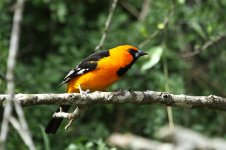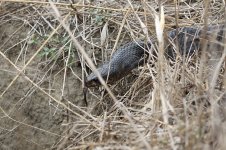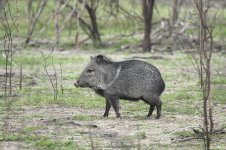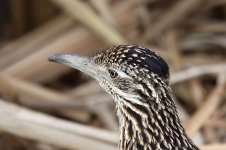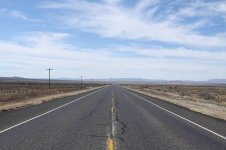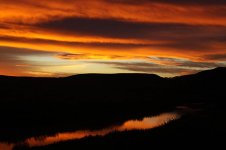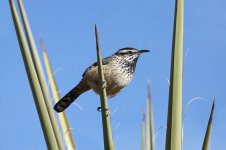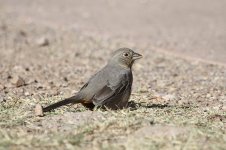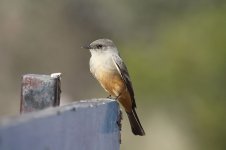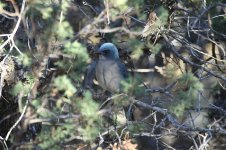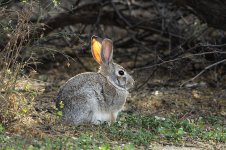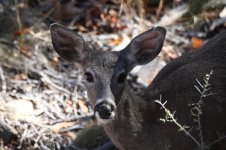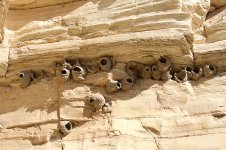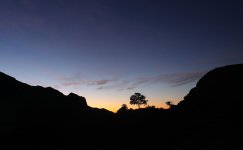-
Welcome to BirdForum, the internet's largest birding community with thousands of members from all over the world. The forums are dedicated to wild birds, birding, binoculars and equipment and all that goes with it.
Please register for an account to take part in the discussions in the forum, post your pictures in the gallery and more.
You are using an out of date browser. It may not display this or other websites correctly.
You should upgrade or use an alternative browser.
You should upgrade or use an alternative browser.
Road Trip USA, Texas & New Mexico (1 Viewer)
- Thread starter Jos Stratford
- Start date
More options
Who Replied?Jeff Hopkins
Just another...observer

Love the pussy cat!
stuartvine
Well-known member
Love the alligators!
stuartvine
Well-known member
Love the idea of Jos on a choo choo train
Hmm, suspiciously few photos of that ;-)

Hmm, suspiciously few photos of that ;-)
Somehow forgot to do the selfie :-O

20 December. Anzalduas Country Park.
The lower Rio Grande valley is brimming with simply dozens of top rate birding localities - amongst the best that I didn't visit being Sabal Palm and Bentson-Rio Grande. I did however visit Anzalduas Country Park, a small recreational park in a loop of the Rio Grande that at first glance might seem a shadow of some of these other localities. Prime reasons for me visiting were that the site was holding a Greater Pewee at the time of my visit, a Texas rarity, and that Zone-tailed Hawks were being reported with some regularity.
So it was, a little before dawn, I departed South Padre for the 90 mile cruise along Highway 100 and Interstate 2 to reach the site, one abrupt stop on the former producing a Ringed Kingfisher on wires peering down into a roadside pool. A site that sometimes attracts Short-eared Owls, I began the morning by exploring a levee along the Rio Grande about half a mile before Anzalduas. No owls on this day, but quite splendid all the same - sprawling across a small field and adjacent hedge, no less than 50 Black Vultures and 25 Crested Caracaras at roost, most simply sitting on the ground. Also one Northern Harrier, a couple of White-tailed Kites, a half dozen American Kestrels and, powering across the sky, one adult Peregrine. Also a Coyote here.
Moving across to Anzalduas itself, flocks of Western Meadowlarks were immediately apparent in a riverside field and a mixed bunch of Lark Sparrows, Chipping Sparrows and Savannah Sparrows fed on lawns dedicated to picnic areas, 14 Eastern Bluebirds also in the same area. Parking at the main boat quay, Mexico a mere stone's throw across the water, my second Ringed Kingfisher of the day sat on a tree stump mid-channel, while Spotted Sandpiper, Osprey and Caspian Tern were also noted. A Canvasback, one of very few during the whole trip, associated with about 80 Lesser Scaup.
My main target for the day, the Greater Pewee, should have been an easy enough bird to find I thought - a large flycatcher that tends to perch on open exposed snags, it had to be simple to find, especially as the bird was favoring a relatively limited area of the picnic grounds. Hmm, perhaps it was asleep, I zigzagged around the relevant area, and most of the rest of Anzalduas, for a good couple of hours without a slightest glimpse of the bird! Several Green Jays present, three Eastern Phoebes, even a couple of Black Phoebes near the river, but not a Greater Pewee anywhere. American White Pelicans and Double-crested Cormorants flew up the valley, a few Tree Swallows skimmed over the river, one Couch's Kingbird and one Great Kiskadee added to the day list. Then, after a pause for coffee and now mid-morning, I took another walk around the favored area ...and there, as prominent as could be, the Greater Pewee atop a dead branch poking up from one of the big trees! And there it stayed for the duration of my visit, flying sorties to catch flies, returning to the same or other equally obvious vantage points. I really couldn't imagine where the bird had been earlier - perhaps a quick trip over to Mexico or maybe Greater Pewees really are late risers!
Anyhow, with success on the main bird, I then turned my attention to the rising thermals just to the west ...huge kettles of Turkey Vultures were rising out of riverside woodland, perhaps a few things in their midst? Settling down on a sunny bank, I began to scan ...some hundreds of Turkey Vultures - almost too many, virtually every bird, distant dot or close thing lumbering, turned out to be one. But not quite all ...quickly picked up a couple of Red-tailed Hawks, then considerably later, first an immature Grey Hawk, then an adult Zone-tailed Hawk. Success!
On route back, a small detour to the Hidalgo pumphouse successfully added the third member of Psittacidae family to the trip list - Monk Parakeets at the junctions of East Gardenia and 5th Street, several pairs actively nest-building on electricity posts. Also saw several House Finches here, my first of the trip.
With that, I returned to the coast for a change of scene, deciding to spend the rest of the day on the beaches and mudflats of South Padre Island. Took me a few tries to find a really good area, randomly turning towards Laguna Madre at various points. Osprey, Roseate Spoonbill, Reddish Egret and Black Skimmer along the way, then I stumbled across what I was looking for - a couple of small bays, the low tide exposing flats of mud quite full of roosting waders. A couple of hundred waders in the first, Snowy Plovers, Semipalmated Plovers, Least Sandpipers, Dunlins and Sanderling making up the bulk, but in the second bay, though total wader numbers were lower, the prize was awaiting ...one most quaint Piping Plover, a sparse breeder along this coast. Also in these bays, a few Western Sandpipers, a bunch of Black-bellied Plovers, both Greater and Lesser Yellowlegs, a whole load of Ruddy Turnstones and several Long-billed Curlews.
The lower Rio Grande valley is brimming with simply dozens of top rate birding localities - amongst the best that I didn't visit being Sabal Palm and Bentson-Rio Grande. I did however visit Anzalduas Country Park, a small recreational park in a loop of the Rio Grande that at first glance might seem a shadow of some of these other localities. Prime reasons for me visiting were that the site was holding a Greater Pewee at the time of my visit, a Texas rarity, and that Zone-tailed Hawks were being reported with some regularity.
So it was, a little before dawn, I departed South Padre for the 90 mile cruise along Highway 100 and Interstate 2 to reach the site, one abrupt stop on the former producing a Ringed Kingfisher on wires peering down into a roadside pool. A site that sometimes attracts Short-eared Owls, I began the morning by exploring a levee along the Rio Grande about half a mile before Anzalduas. No owls on this day, but quite splendid all the same - sprawling across a small field and adjacent hedge, no less than 50 Black Vultures and 25 Crested Caracaras at roost, most simply sitting on the ground. Also one Northern Harrier, a couple of White-tailed Kites, a half dozen American Kestrels and, powering across the sky, one adult Peregrine. Also a Coyote here.
Moving across to Anzalduas itself, flocks of Western Meadowlarks were immediately apparent in a riverside field and a mixed bunch of Lark Sparrows, Chipping Sparrows and Savannah Sparrows fed on lawns dedicated to picnic areas, 14 Eastern Bluebirds also in the same area. Parking at the main boat quay, Mexico a mere stone's throw across the water, my second Ringed Kingfisher of the day sat on a tree stump mid-channel, while Spotted Sandpiper, Osprey and Caspian Tern were also noted. A Canvasback, one of very few during the whole trip, associated with about 80 Lesser Scaup.
My main target for the day, the Greater Pewee, should have been an easy enough bird to find I thought - a large flycatcher that tends to perch on open exposed snags, it had to be simple to find, especially as the bird was favoring a relatively limited area of the picnic grounds. Hmm, perhaps it was asleep, I zigzagged around the relevant area, and most of the rest of Anzalduas, for a good couple of hours without a slightest glimpse of the bird! Several Green Jays present, three Eastern Phoebes, even a couple of Black Phoebes near the river, but not a Greater Pewee anywhere. American White Pelicans and Double-crested Cormorants flew up the valley, a few Tree Swallows skimmed over the river, one Couch's Kingbird and one Great Kiskadee added to the day list. Then, after a pause for coffee and now mid-morning, I took another walk around the favored area ...and there, as prominent as could be, the Greater Pewee atop a dead branch poking up from one of the big trees! And there it stayed for the duration of my visit, flying sorties to catch flies, returning to the same or other equally obvious vantage points. I really couldn't imagine where the bird had been earlier - perhaps a quick trip over to Mexico or maybe Greater Pewees really are late risers!
Anyhow, with success on the main bird, I then turned my attention to the rising thermals just to the west ...huge kettles of Turkey Vultures were rising out of riverside woodland, perhaps a few things in their midst? Settling down on a sunny bank, I began to scan ...some hundreds of Turkey Vultures - almost too many, virtually every bird, distant dot or close thing lumbering, turned out to be one. But not quite all ...quickly picked up a couple of Red-tailed Hawks, then considerably later, first an immature Grey Hawk, then an adult Zone-tailed Hawk. Success!
On route back, a small detour to the Hidalgo pumphouse successfully added the third member of Psittacidae family to the trip list - Monk Parakeets at the junctions of East Gardenia and 5th Street, several pairs actively nest-building on electricity posts. Also saw several House Finches here, my first of the trip.
With that, I returned to the coast for a change of scene, deciding to spend the rest of the day on the beaches and mudflats of South Padre Island. Took me a few tries to find a really good area, randomly turning towards Laguna Madre at various points. Osprey, Roseate Spoonbill, Reddish Egret and Black Skimmer along the way, then I stumbled across what I was looking for - a couple of small bays, the low tide exposing flats of mud quite full of roosting waders. A couple of hundred waders in the first, Snowy Plovers, Semipalmated Plovers, Least Sandpipers, Dunlins and Sanderling making up the bulk, but in the second bay, though total wader numbers were lower, the prize was awaiting ...one most quaint Piping Plover, a sparse breeder along this coast. Also in these bays, a few Western Sandpipers, a bunch of Black-bellied Plovers, both Greater and Lesser Yellowlegs, a whole load of Ruddy Turnstones and several Long-billed Curlews.

Bit delayed doing this report, time to catch up!

21 December. Salineno & Falcon Dam.
I had been in the lower Rio Grande for just three days, a pretty incredible three days that had added 27 birds to my ABA list, rather more than I had expected. Now however was time to move - my next planned destination was the legendary Big Bend National Park, a drive of 1050 km to the west. I had initially planned to do this jump in a single overnight haul, but eventually modified my plans to do it over two days with prolonged stops at Salineno, Falcon Dam and Amistad Reservoir.
Famed for quite many years for its feeders, Salineno is basically a nondescript patch of scrub tucked up against the Mexican border. Here, some years back, a couple established feeders that soon became a magnet for birders across the U.S. Attracting not only the typical specialities of the Rio Grande, the site also hosted up to three species of oriole and, more importantly, Brown Jays - the last ever locality to hold them in the United States. Unfortunately, the range of Brown Jays has continued to contract and, as of 2010, the species no longer occurs at Salineno, thereby becoming extinct in the U.S.
Fortunately, other than the Brown Jays, the feeders still attract many other birds. To an unexpected overcast sky, I arrived at Salineno about an hour after dawn, first exploring the banks of the Rio Grande - no wintering Red-billed Pigeons this year, but a good medley of riverine birds including Ringed Kingfishers, Neotropic Cormorants, Pied-billed Grebes and Spotted Sandpipers, plus Black-crested Titmice and Blue-grey Gnatcatchers in the scrub. Just up the slope, the feeders were a treat indeed - settling onto the provided chairs, a spectacle unfolded metres in front - a flurry of action at a dozen or more feeders and scattered chunks of fruit: Green Jays and Great Kiskadees a couple of dozen apiece, 60 plus Red-winged Blackbirds, several Golden-fronted Woodpeckers, a handful of Black-crested Titmice, White-tipped Doves and White-winged Doves both plodding the ground, plus occasional Long-billed Thrashers, Olive Sparrows and Orange-crowned Warblers. House Sparrows and Great-tailed Grackles both abundant.
The undoubted stars of the site though are the orioles - Altamira, Audubon's and Hooded all possible during the winter. With at least six present, Altamira Orioles were very easy to see, almost non-stop feeding on the citrus fruit. The other two were more problematic - Hooded was basically not present, an occasional being seen every couple of weeks or so, while a pair of Audubon's were visiting two or three times a day, though generally elusive. So, I sat back to wait, the bustle of the feeders quite a pleasure, a Sharp-shinned Hawk emptying the site on a couple of occasions as it came hurtling through, overhead Crested Caracaras having no such impact. After an hour or so, with no joy on the alternative orioles, I decided to have have another look along the river, maybe I could find one of the orioles there. And that is exactly what I did - a quarter hour on, I found a male Audubon's Oriole feeding in a big riverside willow. The bird however was moving fairly fast ...directly towards the feeders! I doubled back and plonked myself on one of the chairs at the feeders just in time for the bird to arrive, a nice double act of one male Audubon's Oriole feeding to my immediate right, one male Altamira Oriole feeding to the immediate left!
Next stop, just a handful of miles further, Falcon Dam. No real targets here, just a stroll around the arid hillsides abutting the large reservoir. One very photogenic Greater Roadrunner on arrival, one skittish covey of Northern Bobwhites also. I parked in the picnic area and then walked a trail that looped round the slopes ...a typical bunch of species seen, Harris Hawk, Inca Dove and Eastern Bluebird included, also Bewick's Wren and a nice flock of mixed sparrows - five species at least, Savannah Sparrows most, but Cassin's, Chipping, Vesper and Lincoln's Sparrows all also present. Also found my only snake of the trip - a long black Indigo Snake that slithered into a hole - and, almost back where I had left the car, a rather nice pack of 12 Collared Peccaries. One Black-tailed Jack Rabbit too.
Thereafter it was a long drive westbound, a brief stop at a pool in Zapata failing to produce hoped-for White-collared Seedeaters (but resulting in a Green Kingfisher). As dusk fell, approaching the city of Del Rio, the ghostly shapes of two Great Horned Owls appeared on roadside posts, the birds dueting to each other. Checked into a hotel in Del Rio, the large Amistad Reservoir nearby for morning exploration.
I had been in the lower Rio Grande for just three days, a pretty incredible three days that had added 27 birds to my ABA list, rather more than I had expected. Now however was time to move - my next planned destination was the legendary Big Bend National Park, a drive of 1050 km to the west. I had initially planned to do this jump in a single overnight haul, but eventually modified my plans to do it over two days with prolonged stops at Salineno, Falcon Dam and Amistad Reservoir.
Famed for quite many years for its feeders, Salineno is basically a nondescript patch of scrub tucked up against the Mexican border. Here, some years back, a couple established feeders that soon became a magnet for birders across the U.S. Attracting not only the typical specialities of the Rio Grande, the site also hosted up to three species of oriole and, more importantly, Brown Jays - the last ever locality to hold them in the United States. Unfortunately, the range of Brown Jays has continued to contract and, as of 2010, the species no longer occurs at Salineno, thereby becoming extinct in the U.S.
Fortunately, other than the Brown Jays, the feeders still attract many other birds. To an unexpected overcast sky, I arrived at Salineno about an hour after dawn, first exploring the banks of the Rio Grande - no wintering Red-billed Pigeons this year, but a good medley of riverine birds including Ringed Kingfishers, Neotropic Cormorants, Pied-billed Grebes and Spotted Sandpipers, plus Black-crested Titmice and Blue-grey Gnatcatchers in the scrub. Just up the slope, the feeders were a treat indeed - settling onto the provided chairs, a spectacle unfolded metres in front - a flurry of action at a dozen or more feeders and scattered chunks of fruit: Green Jays and Great Kiskadees a couple of dozen apiece, 60 plus Red-winged Blackbirds, several Golden-fronted Woodpeckers, a handful of Black-crested Titmice, White-tipped Doves and White-winged Doves both plodding the ground, plus occasional Long-billed Thrashers, Olive Sparrows and Orange-crowned Warblers. House Sparrows and Great-tailed Grackles both abundant.
The undoubted stars of the site though are the orioles - Altamira, Audubon's and Hooded all possible during the winter. With at least six present, Altamira Orioles were very easy to see, almost non-stop feeding on the citrus fruit. The other two were more problematic - Hooded was basically not present, an occasional being seen every couple of weeks or so, while a pair of Audubon's were visiting two or three times a day, though generally elusive. So, I sat back to wait, the bustle of the feeders quite a pleasure, a Sharp-shinned Hawk emptying the site on a couple of occasions as it came hurtling through, overhead Crested Caracaras having no such impact. After an hour or so, with no joy on the alternative orioles, I decided to have have another look along the river, maybe I could find one of the orioles there. And that is exactly what I did - a quarter hour on, I found a male Audubon's Oriole feeding in a big riverside willow. The bird however was moving fairly fast ...directly towards the feeders! I doubled back and plonked myself on one of the chairs at the feeders just in time for the bird to arrive, a nice double act of one male Audubon's Oriole feeding to my immediate right, one male Altamira Oriole feeding to the immediate left!
Next stop, just a handful of miles further, Falcon Dam. No real targets here, just a stroll around the arid hillsides abutting the large reservoir. One very photogenic Greater Roadrunner on arrival, one skittish covey of Northern Bobwhites also. I parked in the picnic area and then walked a trail that looped round the slopes ...a typical bunch of species seen, Harris Hawk, Inca Dove and Eastern Bluebird included, also Bewick's Wren and a nice flock of mixed sparrows - five species at least, Savannah Sparrows most, but Cassin's, Chipping, Vesper and Lincoln's Sparrows all also present. Also found my only snake of the trip - a long black Indigo Snake that slithered into a hole - and, almost back where I had left the car, a rather nice pack of 12 Collared Peccaries. One Black-tailed Jack Rabbit too.
Thereafter it was a long drive westbound, a brief stop at a pool in Zapata failing to produce hoped-for White-collared Seedeaters (but resulting in a Green Kingfisher). As dusk fell, approaching the city of Del Rio, the ghostly shapes of two Great Horned Owls appeared on roadside posts, the birds dueting to each other. Checked into a hotel in Del Rio, the large Amistad Reservoir nearby for morning exploration.


22 December. Amistad Reservoir & Big Bend National Park.
The big drive continues, 420 km still to go. Started the morning however with an amble around the arid shores of the large Amistad Reservoir. Having long left the lower portions of the Rio Grande behind, it was a far more desert mix of species here, smart Black-throated Sparrows becoming common, super stunning Cactus Wrens poking about in the succulents, the first Chihuahuan Ravens flying over. Adjacent to a small campsite, one particular patch of thick scrub proved most productive – amongst small flocks of Savannah and Black-throated Sparrows, a little group of Black-tailed Gnatcatchers were buzzing about, a couple of Ladder-backed Woodpeckers also and two Pyrrhuloxias. Also several Cactus Wrens popping up and down, bunches of Western Meadowlarks, a few Eastern Phoebes and one Loggerhead Shrike. With relatively limited time, I didn't pay a lot of attention to the actual lake – other than to note that several bays off Highway 277 were crammed with American Coots and assorted ducks and, rather more impressive, a bay near the main dam on Highway 90 held a Pacific Loon, a vagrant species in Texas. Belted Kingfisher, Eared Grebe and Pied-billed Grebe at the same spot.
With that, it was back to the road, desert landscapes rolling by as the kilometres and hours passed, relatively few birds in the arid lands, no significant stops. Encountered a herd of Pronghorns as I approached the junction settlement of Marathon, then made an abrupt turn to the south. An hour later, I was in Big Bend National Park.
Land of the big skies, of canyons and arid mountains, of Mountain Lions and Black Bears, this was a destination I have wanted to visit for many a year. Was late in the day by the time I arrived, the sun casting wonderful shades over the meandering road that dropped towards the Rio Grande, a couple of Greater Roadrunners awaiting in the riverside campsite to greet our arrival. Chucked up the tent, had a quick look round the majestic cottonwoods that provided shade, both Black and Say's Phoebes noted, plus a bevy of woodpeckers including at least five Yellow-bellied Sapsuckers and and four Golden-fronted Woodpeckers. As the sun set, it was time for my first night-time explorations, re-tracking my route up towards the centre of the national park. High hopes of seeing critters all over the place were quickly dampened by the realisation that the high chaparral in many areas actually made it rather difficult to see anything more than a few metres from the road! Still, plenty of Desert Cottontails, one Black-tailed Jack Rabbit, an engaging pair of Coyotes and, flying straight over the heads of the Coyotes, one Great Horned Owl. Back at the campsite, a Grey Fox sniffed around, clearly keen on a bit of scavenging, but keeping mostly to thickets.
The big drive continues, 420 km still to go. Started the morning however with an amble around the arid shores of the large Amistad Reservoir. Having long left the lower portions of the Rio Grande behind, it was a far more desert mix of species here, smart Black-throated Sparrows becoming common, super stunning Cactus Wrens poking about in the succulents, the first Chihuahuan Ravens flying over. Adjacent to a small campsite, one particular patch of thick scrub proved most productive – amongst small flocks of Savannah and Black-throated Sparrows, a little group of Black-tailed Gnatcatchers were buzzing about, a couple of Ladder-backed Woodpeckers also and two Pyrrhuloxias. Also several Cactus Wrens popping up and down, bunches of Western Meadowlarks, a few Eastern Phoebes and one Loggerhead Shrike. With relatively limited time, I didn't pay a lot of attention to the actual lake – other than to note that several bays off Highway 277 were crammed with American Coots and assorted ducks and, rather more impressive, a bay near the main dam on Highway 90 held a Pacific Loon, a vagrant species in Texas. Belted Kingfisher, Eared Grebe and Pied-billed Grebe at the same spot.
With that, it was back to the road, desert landscapes rolling by as the kilometres and hours passed, relatively few birds in the arid lands, no significant stops. Encountered a herd of Pronghorns as I approached the junction settlement of Marathon, then made an abrupt turn to the south. An hour later, I was in Big Bend National Park.
Land of the big skies, of canyons and arid mountains, of Mountain Lions and Black Bears, this was a destination I have wanted to visit for many a year. Was late in the day by the time I arrived, the sun casting wonderful shades over the meandering road that dropped towards the Rio Grande, a couple of Greater Roadrunners awaiting in the riverside campsite to greet our arrival. Chucked up the tent, had a quick look round the majestic cottonwoods that provided shade, both Black and Say's Phoebes noted, plus a bevy of woodpeckers including at least five Yellow-bellied Sapsuckers and and four Golden-fronted Woodpeckers. As the sun set, it was time for my first night-time explorations, re-tracking my route up towards the centre of the national park. High hopes of seeing critters all over the place were quickly dampened by the realisation that the high chaparral in many areas actually made it rather difficult to see anything more than a few metres from the road! Still, plenty of Desert Cottontails, one Black-tailed Jack Rabbit, an engaging pair of Coyotes and, flying straight over the heads of the Coyotes, one Great Horned Owl. Back at the campsite, a Grey Fox sniffed around, clearly keen on a bit of scavenging, but keeping mostly to thickets.



23 December. Big Bend National Park.
The Chisos Mountains dominate the heart of Big Bend National Park, an isolated massif with high slopes cloaked in pine and peaks rising to almost 2400 metres. Many restricted range species in these here hills, I was quite looking forward to a day of hiking. The fun however started in the parking lot at the Chisos Basin trailhead - hikers preparing for their climbs, folks trundling into the visitor centre, cars spilling out their inhabitants to gawk at the scenery around ...and right in their midst, a couple of Greater Roadrunners prancing around, a Say's Phoebe hawking from a sign post smack bang in the middle of all the people and quite a few Canyon Towhees hopping about on the little lawns and poking around under cars, the latter a new species for me. I had not expected to spend half the morning exploring a car park and its environs, but truly the birding was excellent. Coffee in one hand and camera in the other, I basked under the already warm sun and enjoyed the spectacle - all the above birds non-stop, plus a bunch of Cactus Wrens in planted vegetation around small cabins, a flock of Black-crested Titmice in bushes and, along a small track to more cabins, a mixed flock of sparrows that included two Black-chinned Sparrows (another new species for me), five Rufous-crowned Sparrows, three White-throated Sparrows and a Dark-eyed Junco. A quick skirt through the nearby campsite added four Black-throated Sparrows, another couple of Greater Roadrunners and Curve-billed Thrasher.
I was however still missing one key bird - Mexican Jay. So, finally taking to the trails, I hiked upwards, a couple of Mule Deers on the ascent, Bewick's Wren too. Rather hot now, so reaching a relatively flat area a couple of kilometres up, I was quite happy to take a pause to seek out a woodpecker tap tap tapping from pines nearby. Turned out to be not one bird in the grove, but at least four ...two Ladder-backed Woodpeckers, one Yellow-bellied Sapsucker and, best of the lot, one smart Red-naped Sapsucker. Then, retracing my way back to the path, a 'craa craaa' from pines just up the slope, then flashes of subtle blues and soft greys ...a family party of five, Mexican Jays! So it was, I had found my main target of the day, and very nice they were too. Found another party of five during the descent, plus one Texas Antelope Squirrel here too.
Now middle afternoon, the temperature an amazing 28 C, I returned back to the Rio Grande, stopping in at the hot springs. Lots of Cave Swallow nests on the arid rocky overhangs, but no actual birds present. A short hike did however add a couple of Pyrrhuloxias, a flock of three Lesser Goldfinches, one Vermilion Flycatcher and, proving themselves most common, yet more Greater Roadrunners.
Nice sunset over the Chisos Mountains. Less than grand was the night drive, adding only a few Desert Cottontails!
The Chisos Mountains dominate the heart of Big Bend National Park, an isolated massif with high slopes cloaked in pine and peaks rising to almost 2400 metres. Many restricted range species in these here hills, I was quite looking forward to a day of hiking. The fun however started in the parking lot at the Chisos Basin trailhead - hikers preparing for their climbs, folks trundling into the visitor centre, cars spilling out their inhabitants to gawk at the scenery around ...and right in their midst, a couple of Greater Roadrunners prancing around, a Say's Phoebe hawking from a sign post smack bang in the middle of all the people and quite a few Canyon Towhees hopping about on the little lawns and poking around under cars, the latter a new species for me. I had not expected to spend half the morning exploring a car park and its environs, but truly the birding was excellent. Coffee in one hand and camera in the other, I basked under the already warm sun and enjoyed the spectacle - all the above birds non-stop, plus a bunch of Cactus Wrens in planted vegetation around small cabins, a flock of Black-crested Titmice in bushes and, along a small track to more cabins, a mixed flock of sparrows that included two Black-chinned Sparrows (another new species for me), five Rufous-crowned Sparrows, three White-throated Sparrows and a Dark-eyed Junco. A quick skirt through the nearby campsite added four Black-throated Sparrows, another couple of Greater Roadrunners and Curve-billed Thrasher.
I was however still missing one key bird - Mexican Jay. So, finally taking to the trails, I hiked upwards, a couple of Mule Deers on the ascent, Bewick's Wren too. Rather hot now, so reaching a relatively flat area a couple of kilometres up, I was quite happy to take a pause to seek out a woodpecker tap tap tapping from pines nearby. Turned out to be not one bird in the grove, but at least four ...two Ladder-backed Woodpeckers, one Yellow-bellied Sapsucker and, best of the lot, one smart Red-naped Sapsucker. Then, retracing my way back to the path, a 'craa craaa' from pines just up the slope, then flashes of subtle blues and soft greys ...a family party of five, Mexican Jays! So it was, I had found my main target of the day, and very nice they were too. Found another party of five during the descent, plus one Texas Antelope Squirrel here too.
Now middle afternoon, the temperature an amazing 28 C, I returned back to the Rio Grande, stopping in at the hot springs. Lots of Cave Swallow nests on the arid rocky overhangs, but no actual birds present. A short hike did however add a couple of Pyrrhuloxias, a flock of three Lesser Goldfinches, one Vermilion Flycatcher and, proving themselves most common, yet more Greater Roadrunners.
Nice sunset over the Chisos Mountains. Less than grand was the night drive, adding only a few Desert Cottontails!
Last edited:



MKinHK
Mike Kilburn

Sounds terrific - lots of quality and the peccary is one cool-looking pig!
Just reading the Kingbird Highway at the moment about Kenn Kaufmann hitching his way round these sites back in the 70s - dipping on White-collared Seed-eaters and ticking Black-chinned Sparrows!
Cheers
Mike
Just reading the Kingbird Highway at the moment about Kenn Kaufmann hitching his way round these sites back in the 70s - dipping on White-collared Seed-eaters and ticking Black-chinned Sparrows!
Cheers
Mike
Jeff Hopkins
Just another...observer

It's been quite a while since I did that run. Not envious of the drive - West Texas may be one of the ugliest locations in the US - but certainly envious of the destination!

24 December. Big Bend National Park.
Christmas Eve, hot in the southern deserts. A hour or two pre-dawn, I emerged from my tent, fantasizing over the thoughts of encountering a Mountain Lion for a Christmas treat. Scanning the chaparral all the way, I meandered back towards the Chisos Mountains, Black-tailed Jack Rabbits and Desert Cottontails along the way. Still dark, I reached the lower slopes of the Chisos, eye shine revealing several Mule Deer. At almost 7.00 a.m., with light beginning to etch form to the hillsides, suddenly a big blob on a slope adjacent to the road, a big black blob with smaller blobs alongside. Oh giddy me, Mexican immigrants – Black Bears! Extinct in the Big Bend for half a century, Black Bears began to recolonise the Chisos Mountains from Mexico in the late 1980s, the population steadily rising since then. And as non-hibernators in these warm southern climates, I was watching a mama bear and three cubs slowly making their way up a shrubby clearing, the rapidly improving lighting showing them a treat. Good advert to oppose the building of the U.S.-Mexico border wall!
Staying on the big critters theme, a Mountain Lion had been seen just after dawn two days earlier along the higher reaches of the Lost Mine Trail, other sightings also occurring in the weeks before. Thus, as the sun began to touch the high ridges, I left the bears and began this hike – Mexican Jays near the trailhead, a Hermit Thrush in a patch of deep forest. Meandering upwards, the path left the forest, crossed a relatively open ridge, then began a series of cutbacks as it climbed a steep lightly wooded slope. A pleasant dotting of birds, amongst them regular Mexican Jays, a flock of active Bushtits and quite a few Rufous-crowned Sparrows. Also Red-naped Sapsucker and, whilst scanning crags and slopes for a possible feline, I picked up my only White-throated Swifts of the trip, a flock of about ten soaring again a precipitous rockface on a distant peak. Mountain Lion was always going to be a long shot, so no big surprise that the only mammals I saw on the way up were three Mule Deer and a couple of Rock Squirrels. At the summit, marked by a large isolated boulder and expanse of exposed rock, views were splendid ...perfect Mountain Lion habitat stretching off in all directions. I sat quite a while and scanned, all to no avail, no cats moving on this morning. I did however, have a Canyon Wren come exploring, an inquisitive bird checking out cracks and fissures in the rocks just below my position – a new bird for me and quite a stunning one at that. Dark-eyed Juncos and Canyon Towhees also around the summit, a couple of Red-tailed Hawks circling overhead. A little bit further down, I also saw two Spotted Towhees and yet more Mexican Jays.
As the first regular hikers of the day began to appear, I left the mountain and returned to the Rio Grande area, Inca Doves, Eastern Phoebe, Vermilion Flycatcher and Rock Wren the highlights. In my original plans I had intended to stay in the Big Bend National Park for four days, but with the superb weather of the first couple of days, I had effectively seen all the species I had hoped to, so I now decided to depart early and add the Davis Mountains to my itinerary.
So, with temperatures up to 29 C, I took down the tents in the early afternoon, packed the car and began the drive north. Regular Greater Roadrunners on route, plus one Loggerhead Shrike, a few Black-throated Sparrows and, prize of the afternoon, a little covey of Scaled Quails scurrying across the road, thereafter poking about between scant bushes and a cactus. Twelve Collared Peccaries also nearby.
Spent the night in small town of Fort Davis, rustic 'wild west' style hotel, everything else shut for Christmas Eve.
25 December. Davis Mountains & McNary.
Cold at dawn in these slightly higher altitudes, a pre-dawn hour or so on the roads failing to produce any hoped-for skunks or other nocturnal mammals. As dawn broke, I was at the McDonald Observatory, beginning a walk through a range of habitats from open lawns and scattered trees to lightly-wooded slopes. A good range of species here, including several new for the trip - these including at least 40 Western Bluebirds, a dozen Western Scrub Jays, one Northern Flicker and three White-breasted Nuthatches. Didn't find any Montezuma Quails that sometimes occur here, so then tried the Davis Mountains campsite, another locality that sometimes gets them. Didn't see them here either, but did find an Acorn Woodpecker, my only one of the trip, plus Ladder-backed Woodpeckers, a Curve-billed Thrasher, stacks more Western Scrub Jays and hundreds of Pine Siskins at feeders near the visitor centre. Collared Peccaries in the campsite too, a pack of them upturning cooler boxes and generally helping themselves to Christmas morning treats.
Montezuma Quail surely deserved a longer stay, but I was keen to push on, the borderlands near El Paso and thereafter New Mexico were both in my sights. Departed Fort Davis at about 11 a.m., taking a westward route via Highways 118, 166 and 90 that crossed the excellent grasslands near Marfa – oodles of White-winged Doves along this way, so too Chihuahuan Ravens and Greater Roadrunners, but even better, a flock of 16 Lark Buntings. Numerous Red-tailed Hawks winter in the area, occasional Ferruginous Hawks also ...I found many of the first, none of the second! Plenty of American Kestrels too, plus one Peregrine and six Northern Harriers.
By late afternoon, with Marfa long behind me and corn dogs and coffees downed on Interstate 10, I reached the turnoff to McNary. One hell of a stink drifting across from a cattle station at the junction, the pause to scan the massive flock of attendant Red-winged Blackbirds brief indeed – a good thousand or so birds present, quite possibly harbouring a Yellow-headed Blackbird or two, but I really couldn't get a good vantage point, so departed before being over assaulted by the stench. Five minutes later, I was aside McNary reservoir, a large waterbody sitting just 300 metres north of the Rio Grande/Mexican border and a magnet to birds in this otherwise arid land. A car sitting aside the border is also a magnet to the U.S. Border Patrol ...within ten minutes of arriving, windows were winding down on a large Border Patrol vehicle, the face of an official appearing. No problem whatsoever, I guess the guys have seen quite a few birders before. So to the reservoir …jam stuffed with Western Grebes, Eared Grebes, American Coots and Common Mergansers, all bobbing on the water in their hundreds! Did a quick scan through, hoping to find a Clark's Grebes ...didn't, but remarkably found another Pacific Loon! These are supposed to be vagrants in Texas, but I had now bumped into two in the space of a week! Also Lesser Scaups, Hooded Mergansers, a flock of Snow Geese and assorted herons here, including five Black-crowned Night Herons.
Leaving the reservoir, I decided to take the 'back road' towards El Paso, i.e. cut along the levees and dirt tracks that hug the river for a few miles until detouring back up to the Interstate. Needless to say, I got stopped a grand total of four times more by the Border Patrol, but credit them, even when I was right by the river, i.e. metres from the Mexican border, they were nothing but friendly – a quick chat and no problems at all about birding this area. And, zigzagging through a maze of small agricultural fields, super birding it was, dozens of Gambel's Quails, commonplace Chihuahuan Ravens, assorted raptors including both Peregrine and Prairie Falcon and, peeping up from a hole in one levee, one Burrowing Owl. Rather surprisingly, I failed to find any flocks of longspurs, larks or sparrows, all of which I thought I had a good chance of here. The only small passerines of note here were singles of Say's Phoebe and Black Phoebe.
Eventually, I turned back onto Interstate 10, zipped west to El Paso and turned north to cross into New Mexico. Arrived well after dark in the town of Truth or Consequences. Ominous warnings of a massive winter storm approaching, media channels talking of blizzards, record-breaking snow and total chaos. Outside, the sky was clear, stars twinkled in the sky.
Christmas Eve, hot in the southern deserts. A hour or two pre-dawn, I emerged from my tent, fantasizing over the thoughts of encountering a Mountain Lion for a Christmas treat. Scanning the chaparral all the way, I meandered back towards the Chisos Mountains, Black-tailed Jack Rabbits and Desert Cottontails along the way. Still dark, I reached the lower slopes of the Chisos, eye shine revealing several Mule Deer. At almost 7.00 a.m., with light beginning to etch form to the hillsides, suddenly a big blob on a slope adjacent to the road, a big black blob with smaller blobs alongside. Oh giddy me, Mexican immigrants – Black Bears! Extinct in the Big Bend for half a century, Black Bears began to recolonise the Chisos Mountains from Mexico in the late 1980s, the population steadily rising since then. And as non-hibernators in these warm southern climates, I was watching a mama bear and three cubs slowly making their way up a shrubby clearing, the rapidly improving lighting showing them a treat. Good advert to oppose the building of the U.S.-Mexico border wall!
Staying on the big critters theme, a Mountain Lion had been seen just after dawn two days earlier along the higher reaches of the Lost Mine Trail, other sightings also occurring in the weeks before. Thus, as the sun began to touch the high ridges, I left the bears and began this hike – Mexican Jays near the trailhead, a Hermit Thrush in a patch of deep forest. Meandering upwards, the path left the forest, crossed a relatively open ridge, then began a series of cutbacks as it climbed a steep lightly wooded slope. A pleasant dotting of birds, amongst them regular Mexican Jays, a flock of active Bushtits and quite a few Rufous-crowned Sparrows. Also Red-naped Sapsucker and, whilst scanning crags and slopes for a possible feline, I picked up my only White-throated Swifts of the trip, a flock of about ten soaring again a precipitous rockface on a distant peak. Mountain Lion was always going to be a long shot, so no big surprise that the only mammals I saw on the way up were three Mule Deer and a couple of Rock Squirrels. At the summit, marked by a large isolated boulder and expanse of exposed rock, views were splendid ...perfect Mountain Lion habitat stretching off in all directions. I sat quite a while and scanned, all to no avail, no cats moving on this morning. I did however, have a Canyon Wren come exploring, an inquisitive bird checking out cracks and fissures in the rocks just below my position – a new bird for me and quite a stunning one at that. Dark-eyed Juncos and Canyon Towhees also around the summit, a couple of Red-tailed Hawks circling overhead. A little bit further down, I also saw two Spotted Towhees and yet more Mexican Jays.
As the first regular hikers of the day began to appear, I left the mountain and returned to the Rio Grande area, Inca Doves, Eastern Phoebe, Vermilion Flycatcher and Rock Wren the highlights. In my original plans I had intended to stay in the Big Bend National Park for four days, but with the superb weather of the first couple of days, I had effectively seen all the species I had hoped to, so I now decided to depart early and add the Davis Mountains to my itinerary.
So, with temperatures up to 29 C, I took down the tents in the early afternoon, packed the car and began the drive north. Regular Greater Roadrunners on route, plus one Loggerhead Shrike, a few Black-throated Sparrows and, prize of the afternoon, a little covey of Scaled Quails scurrying across the road, thereafter poking about between scant bushes and a cactus. Twelve Collared Peccaries also nearby.
Spent the night in small town of Fort Davis, rustic 'wild west' style hotel, everything else shut for Christmas Eve.
25 December. Davis Mountains & McNary.
Cold at dawn in these slightly higher altitudes, a pre-dawn hour or so on the roads failing to produce any hoped-for skunks or other nocturnal mammals. As dawn broke, I was at the McDonald Observatory, beginning a walk through a range of habitats from open lawns and scattered trees to lightly-wooded slopes. A good range of species here, including several new for the trip - these including at least 40 Western Bluebirds, a dozen Western Scrub Jays, one Northern Flicker and three White-breasted Nuthatches. Didn't find any Montezuma Quails that sometimes occur here, so then tried the Davis Mountains campsite, another locality that sometimes gets them. Didn't see them here either, but did find an Acorn Woodpecker, my only one of the trip, plus Ladder-backed Woodpeckers, a Curve-billed Thrasher, stacks more Western Scrub Jays and hundreds of Pine Siskins at feeders near the visitor centre. Collared Peccaries in the campsite too, a pack of them upturning cooler boxes and generally helping themselves to Christmas morning treats.
Montezuma Quail surely deserved a longer stay, but I was keen to push on, the borderlands near El Paso and thereafter New Mexico were both in my sights. Departed Fort Davis at about 11 a.m., taking a westward route via Highways 118, 166 and 90 that crossed the excellent grasslands near Marfa – oodles of White-winged Doves along this way, so too Chihuahuan Ravens and Greater Roadrunners, but even better, a flock of 16 Lark Buntings. Numerous Red-tailed Hawks winter in the area, occasional Ferruginous Hawks also ...I found many of the first, none of the second! Plenty of American Kestrels too, plus one Peregrine and six Northern Harriers.
By late afternoon, with Marfa long behind me and corn dogs and coffees downed on Interstate 10, I reached the turnoff to McNary. One hell of a stink drifting across from a cattle station at the junction, the pause to scan the massive flock of attendant Red-winged Blackbirds brief indeed – a good thousand or so birds present, quite possibly harbouring a Yellow-headed Blackbird or two, but I really couldn't get a good vantage point, so departed before being over assaulted by the stench. Five minutes later, I was aside McNary reservoir, a large waterbody sitting just 300 metres north of the Rio Grande/Mexican border and a magnet to birds in this otherwise arid land. A car sitting aside the border is also a magnet to the U.S. Border Patrol ...within ten minutes of arriving, windows were winding down on a large Border Patrol vehicle, the face of an official appearing. No problem whatsoever, I guess the guys have seen quite a few birders before. So to the reservoir …jam stuffed with Western Grebes, Eared Grebes, American Coots and Common Mergansers, all bobbing on the water in their hundreds! Did a quick scan through, hoping to find a Clark's Grebes ...didn't, but remarkably found another Pacific Loon! These are supposed to be vagrants in Texas, but I had now bumped into two in the space of a week! Also Lesser Scaups, Hooded Mergansers, a flock of Snow Geese and assorted herons here, including five Black-crowned Night Herons.
Leaving the reservoir, I decided to take the 'back road' towards El Paso, i.e. cut along the levees and dirt tracks that hug the river for a few miles until detouring back up to the Interstate. Needless to say, I got stopped a grand total of four times more by the Border Patrol, but credit them, even when I was right by the river, i.e. metres from the Mexican border, they were nothing but friendly – a quick chat and no problems at all about birding this area. And, zigzagging through a maze of small agricultural fields, super birding it was, dozens of Gambel's Quails, commonplace Chihuahuan Ravens, assorted raptors including both Peregrine and Prairie Falcon and, peeping up from a hole in one levee, one Burrowing Owl. Rather surprisingly, I failed to find any flocks of longspurs, larks or sparrows, all of which I thought I had a good chance of here. The only small passerines of note here were singles of Say's Phoebe and Black Phoebe.
Eventually, I turned back onto Interstate 10, zipped west to El Paso and turned north to cross into New Mexico. Arrived well after dark in the town of Truth or Consequences. Ominous warnings of a massive winter storm approaching, media channels talking of blizzards, record-breaking snow and total chaos. Outside, the sky was clear, stars twinkled in the sky.
Users who are viewing this thread
Total: 2 (members: 0, guests: 2)




